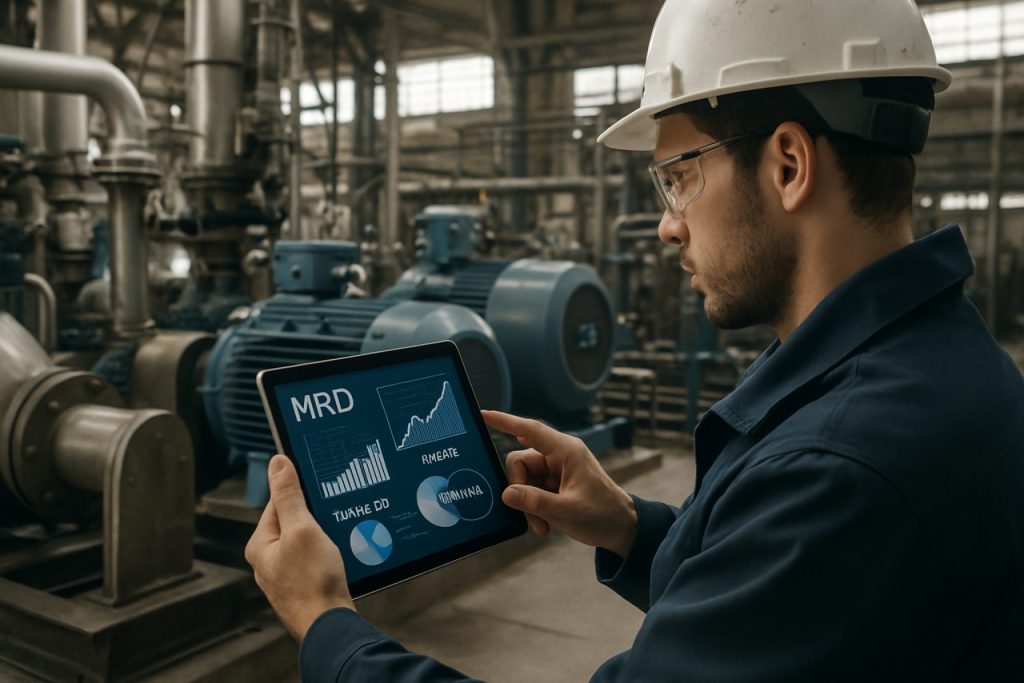
Unlocking the Future of Maintenance: The Game-Changing Impact of Demand-Driven MRO Digitalization. Discover How Smart Technologies Are Transforming Repair and Operations Efficiency Across Industries.
- Introduction: The Urgency for Digital Transformation in MRO
- What Is Demand-Driven MRO Digitalization?
- Key Technologies Powering Demand-Driven MRO
- Benefits: From Predictive Maintenance to Real-Time Inventory Optimization
- Case Studies: Success Stories in MRO Digitalization
- Challenges and Barriers to Adoption
- Best Practices for Implementing Demand-Driven MRO Digitalization
- The Future Outlook: Emerging Trends and Innovations
- Conclusion: Why Demand-Driven MRO Digitalization Is No Longer Optional
- Sources & References
Introduction: The Urgency for Digital Transformation in MRO
The Maintenance, Repair, and Operations (MRO) sector is undergoing a profound transformation, driven by the urgent need to enhance efficiency, reduce costs, and improve asset reliability. Traditional MRO processes, often characterized by manual workflows, siloed data, and reactive maintenance strategies, are increasingly inadequate in meeting the demands of modern industries. The shift toward demand-driven MRO digitalization is not merely a technological upgrade but a strategic imperative for organizations seeking to remain competitive in a rapidly evolving landscape.
Digital transformation in MRO leverages advanced technologies such as the Industrial Internet of Things (IIoT), artificial intelligence, and predictive analytics to enable real-time monitoring, data-driven decision-making, and proactive maintenance interventions. This approach allows organizations to anticipate equipment failures, optimize inventory management, and align maintenance activities with actual operational needs, rather than relying on fixed schedules or historical trends. The result is a more agile, responsive, and cost-effective MRO ecosystem.
The urgency for digital transformation is further underscored by global supply chain disruptions, increasing regulatory pressures, and the growing complexity of industrial assets. Industry leaders and regulatory bodies, such as the International Organization for Standardization, emphasize the importance of digitalization in achieving operational excellence and compliance. As organizations recognize the limitations of legacy systems, the adoption of demand-driven MRO digitalization is becoming a critical enabler of resilience, sustainability, and long-term value creation.
What Is Demand-Driven MRO Digitalization?
Demand-driven MRO (Maintenance, Repair, and Operations) digitalization refers to the strategic use of digital technologies to align MRO processes with real-time operational needs, rather than relying on static, schedule-based approaches. This paradigm shift leverages data analytics, IoT sensors, and cloud-based platforms to monitor equipment health, predict failures, and automate inventory management, ensuring that maintenance activities and spare parts provisioning are triggered by actual demand signals from the field.
Unlike traditional MRO models, which often result in overstocking, delayed repairs, or unnecessary maintenance, demand-driven digitalization enables organizations to optimize resource allocation, reduce downtime, and minimize costs. By integrating digital tools such as predictive maintenance algorithms and digital twins, companies can gain granular visibility into asset conditions and usage patterns, allowing for more precise planning and execution of MRO tasks. This approach is particularly valuable in asset-intensive industries like manufacturing, aviation, and energy, where unplanned outages can have significant financial and operational impacts.
The adoption of demand-driven MRO digitalization is supported by advancements in industrial IoT, artificial intelligence, and cloud computing, which facilitate seamless data collection, analysis, and collaboration across the supply chain. Leading organizations and industry bodies, such as Gartner and McKinsey & Company, highlight the transformative potential of this approach in driving operational efficiency, enhancing asset reliability, and supporting agile, data-driven decision-making in MRO management.
Key Technologies Powering Demand-Driven MRO
The digital transformation of Maintenance, Repair, and Operations (MRO) is increasingly driven by a suite of advanced technologies that enable demand-driven strategies. At the core, the Industrial Internet of Things (IIoT) provides real-time data from sensors embedded in equipment, allowing organizations to monitor asset health and predict maintenance needs with unprecedented accuracy. This data-centric approach is further enhanced by Artificial Intelligence (AI) and Machine Learning (ML) algorithms, which analyze vast datasets to forecast failures, optimize inventory, and automate decision-making processes. For example, predictive maintenance powered by AI can significantly reduce unplanned downtime and extend asset lifecycles, as demonstrated by initiatives from GE Digital.
Cloud computing is another foundational technology, offering scalable storage and processing power for the massive volumes of data generated by IIoT devices. Cloud-based MRO platforms facilitate seamless collaboration across global supply chains, enabling real-time visibility into parts availability and maintenance schedules. Additionally, digital twins—virtual replicas of physical assets—allow for simulation and scenario planning, supporting proactive maintenance and resource allocation. Companies like Siemens are leveraging digital twins to optimize MRO operations.
Blockchain technology is also emerging as a tool for enhancing transparency and traceability in MRO supply chains, ensuring the authenticity of parts and maintenance records. Finally, mobile and augmented reality (AR) solutions empower technicians with instant access to digital manuals, remote expert support, and step-by-step repair guidance, as seen in solutions from PTC. Collectively, these technologies are reshaping MRO into a responsive, data-driven function aligned with real-time operational demands.
Benefits: From Predictive Maintenance to Real-Time Inventory Optimization
Demand-driven MRO digitalization delivers a spectrum of benefits, fundamentally transforming how organizations manage maintenance, repair, and operations. One of the most significant advantages is the enablement of predictive maintenance. By leveraging IoT sensors, machine learning, and advanced analytics, organizations can monitor equipment health in real time, anticipate failures, and schedule interventions only when necessary. This approach reduces unplanned downtime, extends asset lifespans, and optimizes maintenance costs, as demonstrated by initiatives from GE Digital and IBM Maximo.
Another critical benefit is real-time inventory optimization. Traditional MRO inventory management often leads to overstocking or stockouts due to static forecasting and manual processes. Digitalization enables dynamic, demand-driven inventory control by integrating data from equipment sensors, maintenance schedules, and supply chain systems. This integration allows for automated replenishment, accurate demand forecasting, and reduced inventory carrying costs. Companies like SAP and Honeywell have showcased how real-time data can streamline inventory management, ensuring critical parts are available precisely when needed.
Furthermore, demand-driven digitalization enhances collaboration across departments, improves compliance through automated record-keeping, and supports sustainability by minimizing waste. The cumulative effect is a more agile, cost-effective, and resilient MRO operation, positioning organizations to respond swiftly to changing operational demands and market conditions.
Case Studies: Success Stories in MRO Digitalization
The transformative impact of demand-driven MRO digitalization is best illustrated through real-world case studies, where organizations have leveraged digital tools to optimize maintenance, repair, and operations. For instance, Lufthansa Technik implemented a predictive maintenance platform that utilizes real-time aircraft data and advanced analytics to anticipate component failures. This shift from reactive to predictive maintenance has reduced unscheduled downtime and improved parts availability, resulting in significant cost savings and enhanced operational reliability.
Similarly, Siemens adopted a digital MRO solution integrating IoT sensors and cloud-based analytics across its manufacturing plants. By monitoring equipment health and automating spare parts inventory management, Siemens achieved a reduction in maintenance costs and improved asset utilization. The company reported a 20% decrease in unplanned outages and a 15% reduction in inventory holding costs, underscoring the tangible benefits of demand-driven digitalization.
Another notable example is GE Aerospace, which deployed digital twins and AI-driven analytics to optimize engine maintenance schedules. This approach enabled more accurate forecasting of parts demand and maintenance needs, leading to faster turnaround times and improved customer satisfaction.
These success stories demonstrate that demand-driven MRO digitalization not only streamlines operations but also delivers measurable business value. By harnessing data and digital technologies, organizations can transition from traditional, schedule-based maintenance to a more agile, responsive, and cost-effective MRO paradigm.
Challenges and Barriers to Adoption
The adoption of demand-driven MRO digitalization faces several significant challenges and barriers, despite its potential to transform maintenance, repair, and operations processes. One of the primary obstacles is the integration of new digital solutions with legacy systems. Many organizations rely on outdated infrastructure that is not easily compatible with modern digital platforms, leading to costly and complex integration projects. Additionally, data silos and inconsistent data quality can hinder the seamless flow of information required for real-time, demand-driven decision-making.
Another major barrier is organizational resistance to change. Employees accustomed to traditional MRO processes may be reluctant to adopt new digital tools, especially if they perceive them as threats to job security or as adding complexity to their workflows. This resistance can be exacerbated by a lack of digital skills within the workforce, necessitating significant investment in training and change management initiatives.
Cybersecurity concerns also play a critical role, as digitalization increases the attack surface for potential cyber threats. Ensuring the security and integrity of sensitive operational data is paramount, particularly in industries such as aerospace and defense, where MRO activities are mission-critical. Regulatory compliance adds another layer of complexity, as organizations must navigate evolving standards and requirements for digital systems and data handling.
Finally, the high upfront costs associated with digital transformation—ranging from software acquisition to infrastructure upgrades—can be prohibitive, especially for small and medium-sized enterprises. These financial barriers, combined with uncertainty about return on investment, often slow the pace of adoption. Addressing these challenges requires a strategic approach, robust stakeholder engagement, and a clear roadmap for digital transformation, as highlighted by McKinsey & Company and Deloitte.
Best Practices for Implementing Demand-Driven MRO Digitalization
Implementing demand-driven MRO digitalization requires a strategic approach that aligns technology adoption with organizational goals and operational realities. One best practice is to begin with a comprehensive assessment of current MRO processes, identifying inefficiencies and areas where digital tools can deliver the most value. This assessment should involve cross-functional teams, including maintenance, procurement, and IT, to ensure all perspectives are considered.
Another critical practice is the integration of advanced analytics and real-time data collection. Leveraging IoT sensors and predictive analytics enables organizations to shift from reactive to proactive maintenance, reducing downtime and optimizing inventory levels. For example, predictive maintenance platforms can analyze equipment performance data to forecast failures and automatically trigger parts replenishment, as demonstrated by Siemens in their digital MRO solutions.
Change management is also essential. Successful digitalization initiatives require clear communication, training, and stakeholder engagement to overcome resistance and ensure user adoption. Establishing key performance indicators (KPIs) and regularly monitoring progress helps maintain focus and measure the impact of digitalization efforts. According to McKinsey & Company, organizations that set clear targets and foster a culture of continuous improvement are more likely to achieve sustainable results.
Finally, selecting scalable and interoperable digital platforms is vital. Solutions should be able to integrate with existing enterprise resource planning (ERP) and asset management systems, ensuring seamless data flow and minimizing disruption. Collaborating with technology partners, such as IBM, can provide access to industry best practices and accelerate the digital transformation journey.
The Future Outlook: Emerging Trends and Innovations
The future of demand-driven MRO (Maintenance, Repair, and Operations) digitalization is poised for significant transformation, driven by rapid advancements in technology and evolving industry needs. One of the most prominent trends is the integration of artificial intelligence (AI) and machine learning to enable predictive maintenance, allowing organizations to anticipate equipment failures and optimize inventory levels in real time. This shift from reactive to proactive maintenance strategies is expected to reduce downtime and operational costs substantially. Additionally, the adoption of Internet of Things (IoT) devices is expanding, providing granular visibility into asset health and usage patterns, which further enhances demand forecasting accuracy.
Another emerging innovation is the use of digital twins—virtual replicas of physical assets—which facilitate scenario planning and remote monitoring, streamlining maintenance workflows and improving decision-making. Blockchain technology is also gaining traction for its ability to enhance transparency and traceability in MRO supply chains, reducing the risk of counterfeit parts and ensuring regulatory compliance. Furthermore, cloud-based platforms are enabling seamless collaboration among stakeholders, from suppliers to maintenance teams, fostering a more agile and responsive MRO ecosystem.
As these technologies mature, the MRO sector is expected to witness increased automation, data-driven insights, and a shift towards more sustainable practices, such as optimized resource utilization and reduced waste. Industry leaders and organizations like Gartner and McKinsey & Company highlight that embracing these innovations will be crucial for companies aiming to maintain competitiveness and resilience in an increasingly digital and demand-driven landscape.
Conclusion: Why Demand-Driven MRO Digitalization Is No Longer Optional
The transition to demand-driven MRO digitalization is no longer a strategic luxury but a critical necessity for organizations seeking to remain competitive in today’s fast-evolving industrial landscape. Traditional, reactive approaches to maintenance and repair are increasingly inadequate in the face of complex supply chains, heightened customer expectations, and the relentless pace of technological change. Digitalization enables real-time visibility, predictive analytics, and seamless integration across MRO processes, empowering organizations to anticipate needs, minimize downtime, and optimize inventory levels. This shift not only reduces operational costs but also enhances asset reliability and extends equipment lifecycles, directly impacting the bottom line.
Moreover, regulatory pressures and sustainability goals are driving the need for greater transparency and efficiency in MRO operations. Digital tools facilitate compliance by providing accurate, auditable records and supporting proactive risk management. As demonstrated by industry leaders, the adoption of demand-driven digital MRO solutions leads to measurable improvements in service levels, agility, and resilience—qualities that are indispensable in the face of global disruptions and market volatility Accenture.
In summary, organizations that delay digital transformation in MRO risk falling behind, incurring higher costs, and missing out on opportunities for innovation and growth. Embracing demand-driven MRO digitalization is now a fundamental requirement for operational excellence and long-term sustainability Deloitte.
Sources & References
- International Organization for Standardization
- McKinsey & Company
- GE Digital
- Siemens
- IBM Maximo
- Honeywell
- Lufthansa Technik
- GE Aerospace
- Deloitte
- Accenture



